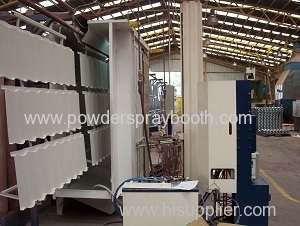Powder coating is a dry finishing process,using finely ground particles of pigment andresin that are generally electrostatically charged and sprayed onto electrically grounded parts.The charged powder particles adhere to theparts and are held there untilmelted and fused into a smooth coating ina curing oven. Before coating,the parts to be coated are firstpretreated similarly to conventional liquid coated parts. The pretreatment process is normally conducted inseries with the coatingand curing operatios.
Thereis essentially two common ways of applying powder coating: by electrostatic spray and by fluidized bed powder coating. There areseveral other processes that have been developed, butthey are far lessused. These include flame spraying, spraying with aplasma gun, airlesshot spray, and coating by electophoretic deposition.
To get an overview of the technology used in the powder coating industry click on the items below:
pretreatment
Electrostatic Spray
curing
Pretreatment.

Phosphating,or conversion coating, is theapplication of an iron or zinc phosphatecoating to the substrate.Conversion coating can be a very critical partof the pretreatment process, adding significantly to the performance ofthe finished coating.A phosphate coating converts the metal substrateto a uniform, inertsurface, which improves bonding, minimizes thespread of oxidation if thecoating is scratchedand improves the overall corrosion resistance of thefinal part.
Aconversion coating can be iron, zinc,polycrystalline, chromate, ormanganese phosphate film. They aredeveloped on both ferrous (ironbased) and non-ferrous surfaces (zinc,aluminum, terne and manganese).Parts are subjected to an acidic bath anda chemical conversion forms acomplete film on the part surface,changing the chemical and physicalnature of the metal surface.
Electrostatic Spray

Electrostatic spray powder coating uses a powder-airmixture from a small fluidized bed in a powder feed hopper. Insomecases, the feed hoppers vibrate to help prevent clogging or clumping of powders prior to entry into the transport lines. The powder issuppliedby a hose to the spray gun, which has a charged electrode in the nozzlefed by a high voltage dc power.
Electrostatic powder spray guns direct the flow of powder; control the deposition rate; control the pattern size, shape, anddensity of the spray; andcharge the powder being sprayed .The spray guns can be manual(hand-held) or automatic, fixed or reciprocating, andmounted on one or both sides of a conveyorized spray booth. Electrostatic spray powder coating operations use collectors to reclaim over-spray.This reclaimed powder is then reused, adding significantly to the powder coating's high transfer efficiency.
There are various gun designs that mainly differ in the method of applying electrostatic charge to the powder. In some cases,the powder is electrostatically charged by friction. The advantage is that the powder is free to deposit in an even layer over the entire surface of the part,and deposition into recesses is improved.
The film thickness is dependent on the powderchemistry, preheat temperature, and dwell time. Film thicknesses of (40 -60 µm) in case of plain powder ( 80 – 100 µm) in case of texture cangenerally be applied on products.
Curing

When a thermoset powder is exposed to elevated temperature, it begins to melt, flows out, and then chemically reacts to form a higher molecular weight polymer in a network-like structure. This cure process, called cross linking, requires a certain degree oftemperature for a certain length of time in order to reach full cure andestablish the full film properties for which the material was designed.Normally the powder scure at 200°C (390°F) in 10 minutes. The curing schedule could vary according to the manufacturer's specifications.
The application of energy to the product to be cured can be accomplished by convection cure ovens or infrared cure ovens.
























